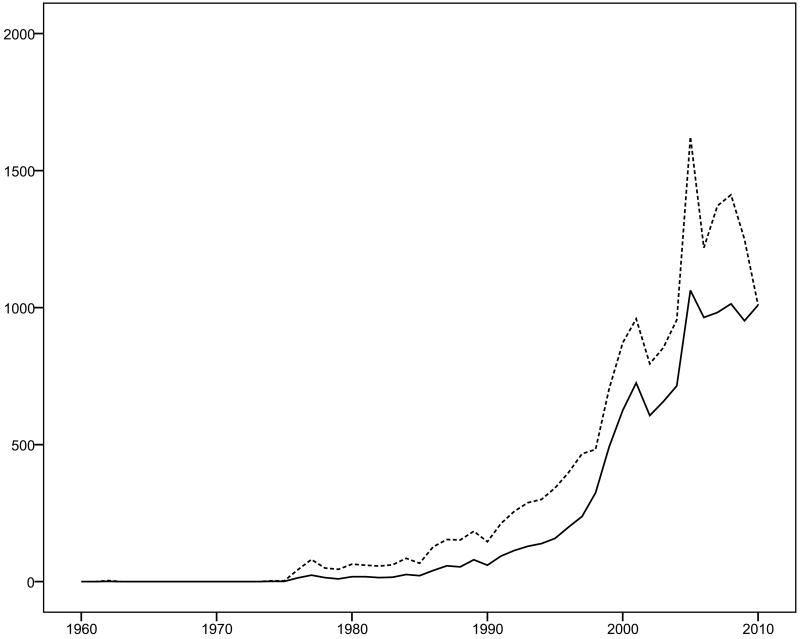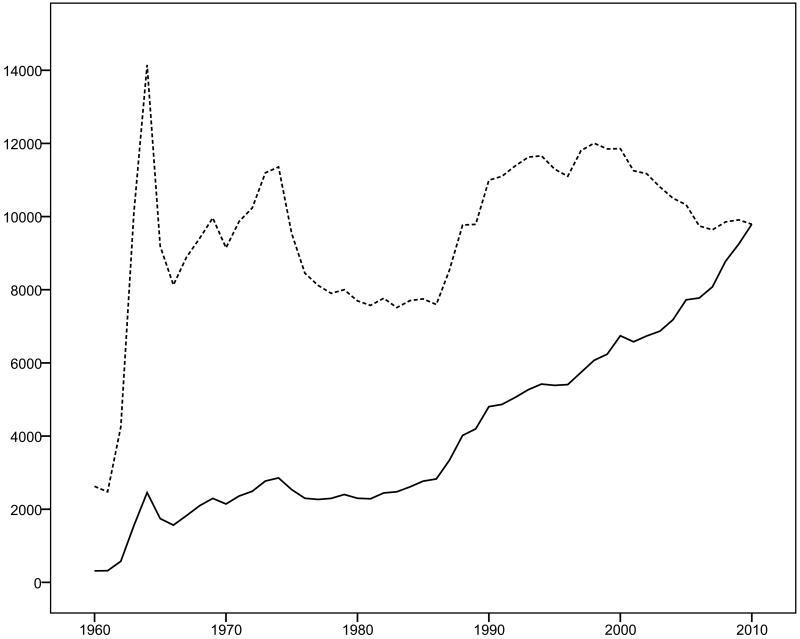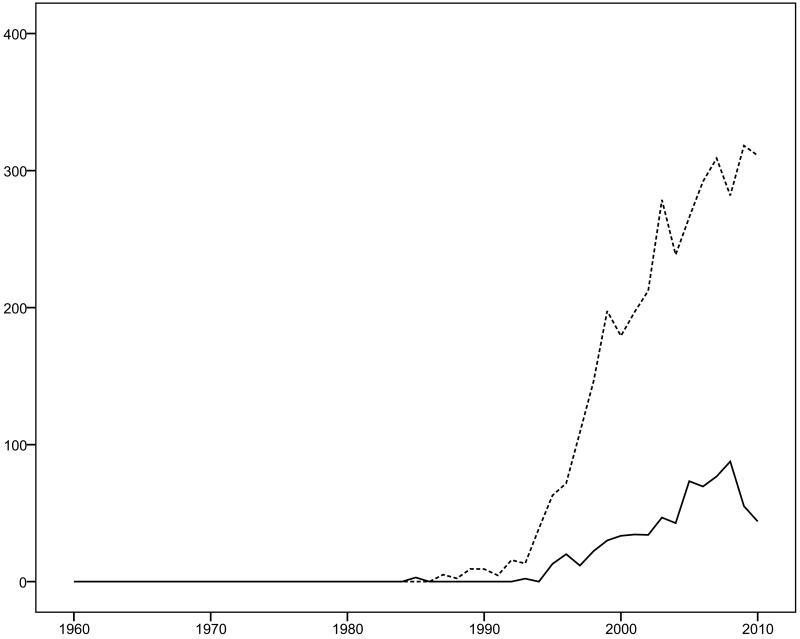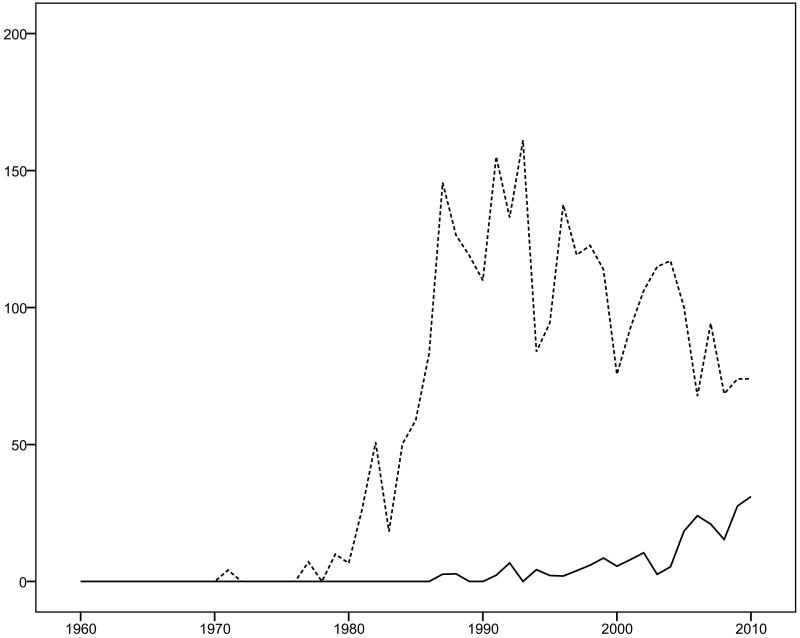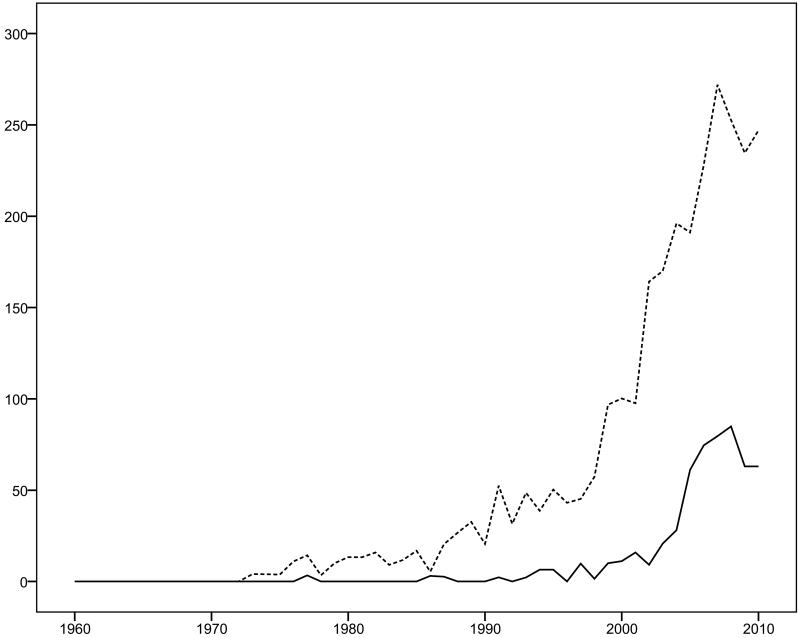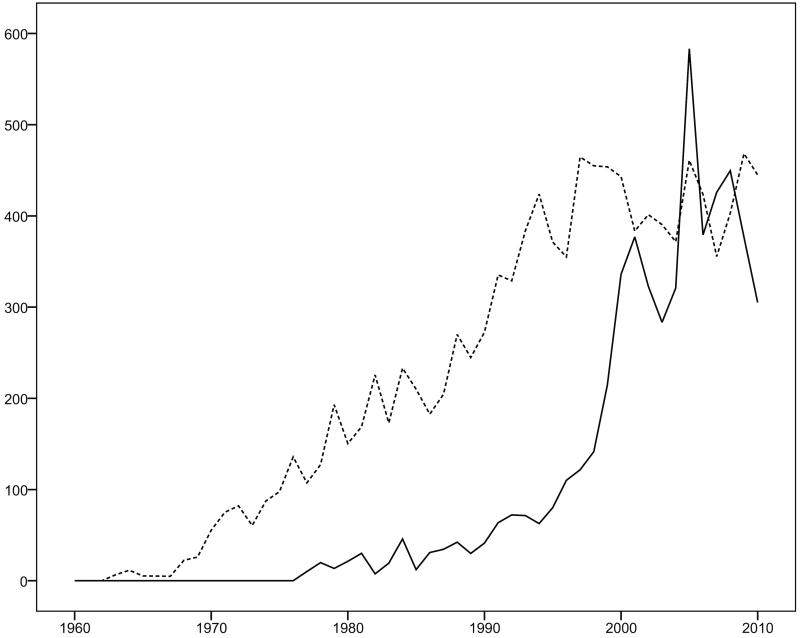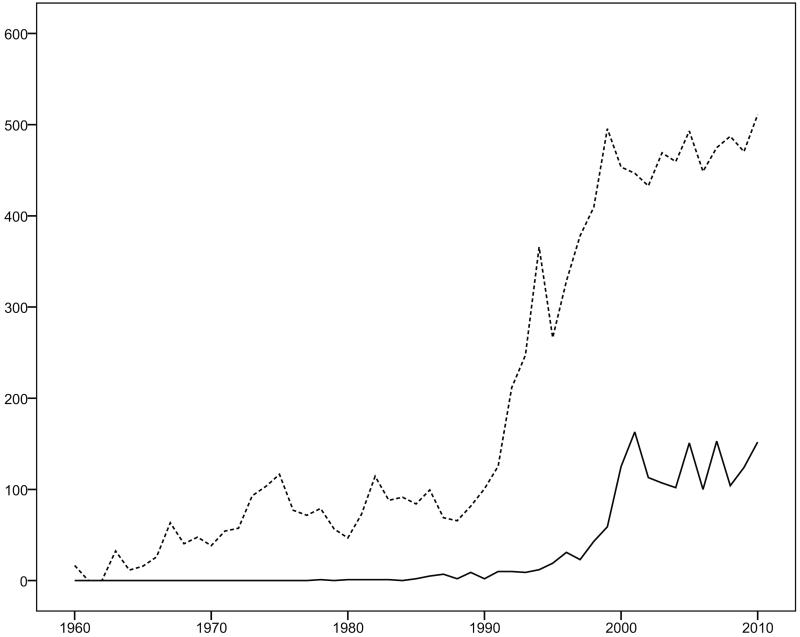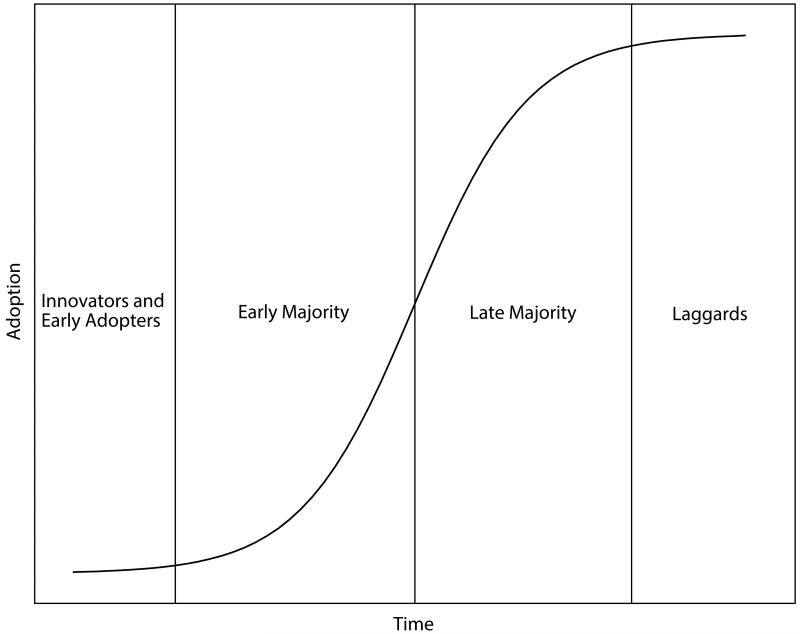Abstract
Object
Technological innovation within healthcare may be defined as the introduction of a new technology that initiates a change in clinical practice. Neurosurgery is a particularly technologically intensive surgical discipline, and new technologies have preceded many of the major advances in operative neurosurgical technique. The aim of the present study was to quantitatively evaluate technological innovation in neurosurgery using patents and peer-reviewed publications as metrics of technology development and clinical translation respectively.
Methods
A patent database was searched between 1960 and 2010 using the search terms “neurosurgeon” OR “neurosurgical” OR “neurosurgery”. The top 50 performing patent codes were then grouped into technology clusters. Patent and publication growth curves were then generated for these technology clusters. A top performing technology cluster was then selected as an exemplar for more detailed analysis of individual patents.
Results
In all, 11,672 patents and 208,203 publications relating to neurosurgery were identified. The top performing technology clusters over the 50 years were: image guidance devices, clinical neurophysiology devices, neuromodulation devices, operating microscopes and endoscopes. Image guidance and neuromodulation devices demonstrated a highly correlated rapid rise in patents and publications, suggesting they are areas of technology expansion. In-depth analysis of neuromodulation patents revealed that the majority of high performing patents were related to Deep Brain Stimulation (DBS).
Conclusions
Patent and publication data may be used to quantitatively evaluate technological innovation in neurosurgery.
Keywords: neurosurgery, technology, technological innovations, diffusion of innovation
INTRODUCTION
Technological innovation within healthcare may be defined as the introduction of a new technology that initiates a change in clinical practice20,24. Neurosurgery is a particularly technologically intensive surgical discipline, and new technologies have preceded many of the major advances in operative neurosurgical technique, including the development of microneurosurgery11,13. While the study of innovation is a relatively mature academic field in social science and industry19, its application in the healthcare setting has been largely qualitative in nature2,4,5,21,22.
Patents may be defined as “the right to exclude others from making, using, offering for sale, or selling an invention” and represent a good metric of technology development24. Similarly, peer-reviewed publications in healthcare journals provide a measure of translational research. Technological innovation may therefore be characterized by a rise in both patent and publication data12.
Recently, patent and publication data have been used to identify clusters of technological innovation in surgery, with emerging innovations lying on the exponential phases of their respective growth curves9. In this study, the same methodology has been employed to first determine the most influential technology clusters in operative neurosurgery over the last 50 years and subsequently to identify areas of contemporaneous growth to aid in the prediction of the important future technologies in neurosurgical practice.
METHODS
Patent and publications
Patent data was obtained using proprietary software PatentInspiration (Ypres, Belgium), which searches the DOCDB database using data from over 90 countries9. Titles, abstracts and descriptions of granted patents were searched from 1960 to 2010 using the Boolean search term: neurosurgeon OR neurosurgical OR neurosurgery. Only single members of patent families were retrieved, to prevent duplication of data. Publication data was obtained using PubMed (National Library of Medicine, Maryland, USA), and the same search strategy.
Over time both patent and publication counts have been rising exponentially in all fields (Figure 1). A previously described equation9 was therefore applied to normalize both patent and publication counts using data from 2010 (the year reporting the greatest number of patents and publications).
Figure 1.
Plots of (a) patents and (b) publications related to neurosurgery over time (solid line = raw data; dashed line = normalized data).
Top performing technology clusters
Following compilation of the patent dataset, the top 50 performing patent codes over the last 50 years (those codes for which the greatest number of patents had been applied for) were identified9. Patent codes describing non-technological advances (such as drugs), or not relating to operative neurosurgery, were excluded. Remaining patent codes were grouped into clusters of related surgical technologies by two authors (HJM and RMK), with any disagreements arbitrated by a third author (AHH). The top performing technology clusters were then individually evaluated by performing further patent and publication searches (see Table 1 for search strategies).
Table 1.
Search strategies
| Search strategies | |
|---|---|
| Image Guidance Devices | (“image guidance” OR “image guided” OR “augmented reality” OR “image fusion” OR “image overlay” OR neuronavigation) AND (neurosurgery OR neurosurgeon OR neurosurgical) |
| Clinical Neurophysiology Devices including those measuring Motor Evoked Potentials and Somatosensory Evoked Potentials | (“Motor Evoked Potentials” OR MEP OR “Somatosensory Evoked Potentials” OR SSEP) AND (neurosurgery OR neurosurgeon OR neurosurgical) |
| Neuromodulation Devices including those for Deep Brain Stimulation, Spinal Cord Stimulation, and Peripheral Nerve Stimulation | (“deep brain stimulation” OR dbs OR “spinal cord stimulation” OR “spinal cord stimulator” OR “peripheral nerve stimulation” OR “peripheral nerve stimulator”) AND (neurosurgery OR neurosurgeon OR neurosurgical) |
| Operating Microscopes | (microscope OR microsurgery OR microneurosurgery) AND (neurosurgery OR neurosurgeon OR neurosurgical) |
| Endoscopes | (endoscope OR endoscopy OR endoscopic OR neuroendoscope OR neuroendoscopy OR neuroendoscopic OR neuro-endoscope OR neuro-endoscopy OR neuro-endoscopic) AND (neurosurgery OR neurosurgeon OR neurosurgical) |
The above methodology was then repeated for patents and publications over the last 5 years of the dataset, from 2005 to 2010. Comparison of the top performing patent codes over these different timescales allowed for more recent technological developments to be determined.
Top performing technology patents
A top performing technology cluster was then selected as an exemplar for more detailed analysis of individual patents. The impact of each patent (i) within the dataset was determined using their year of publication (yi), number of forward citations (ci), and family size (fi). Scores were derived from each of these variables, and a total score calculated, using the equations below. Within the dataset, cmax was the maximum number of citations held by a patent, and fmax was the largest patent family.
The top 50 performing patents were then retrieved for in-depth review. Patents describing non-technological advances (such as drugs), or not relating to operative neurosurgery, were again excluded. This approach to quantifying the impact of individual patents has been utilized by industry to identify landmark patents, but has not yet been described in the healthcare literature.
Statistical analysis
Data were analyzed with Statistical Package for the Social Sciences (SPSS) v 20.0 (Illinois, USA). Patent and publication data were plotted against each other to determine whether their relationship was monotonic. If so, Pearson’s (r) or Spearman’s rank (rs) correlation coefficient was applied to determine the strength of their relationship, depending on whether the association was linear or non-linear respectively.
RESULTS
Patents and publications
In all, 11,672 patents and 208,203 publications relating to neurosurgery between 1960 and 2010 were identified. The original and normalized patent and publication data are presented in Figure 1. Normalized patent counts demonstrated a peak at 2005. Normalized publication counts demonstrated an early peak in 1964 and a late peak in 1998.
Top performing technology clusters
The top performing technology clusters over the 50 years are summarized in Table 2. Approximately half the patent codes concerned non-technological advances such as drugs. Of the remaining patent codes, the largest cluster was image guidance devices, accounting for 37.9% of those granted. The remaining technology clusters identified were: clinical neurophysiology devices (including those recording Motor Evoked Potentials and Somatosensory Evoked Potentials), neuromodulation devices (including those for Deep Brain Stimulation, Spinal Cord Stimulation, and Peripheral Nerve Stimulation), operating microscopes, and endoscopes.
Table 2.
Top 50 performing patent codes over (a) between 1960 and 2010, and (b) between 2005 and 2010.
| Rank | Technology cluster | Number of codes | Number of patents* |
|---|---|---|---|
| 1960 – 2010 | |||
| 1 | Image Guidance Devices | 8 | 2625 (37.9%) |
| 2 | Clinical Neurophysiology Devices, including those measuring Motor Evoked Potentials and Somatosensory Evoked Potentials | 4 | 1450 (21.0%) |
| 3 | Neuromodulation Devices, including those for Deep Brain Stimulation, Spinal Cord Stimulation, and Peripheral Nerve Stimulation | 4 | 1294 (18.7%) |
| 4 | Operating Microscopes | 2 | 420 (6.1%) |
| 5 | Endoscopes | 2 | 391 (5.7%) |
| 6 | Miscellaneous | 4 | 738 (10.7%) |
| 2005 – 2010 | |||
| 1 | Image Guidance Systems | 9 | 1110 (46.0%) |
| 2 | Clinical Neurophysiology Devices, including those measuring Motor Evoked Potentials and Somatosensory Evoked Potentials | 5 | 532 (22.0%) |
| 3 | Neuromodulation Devices, including those for Deep Brain Stimulation, Spinal Cord Stimulation, and Peripheral Nerve Stimulation | 3 | 517 (21.4%) |
| 4 | Endoscopes | 2 | 152 (6.3%) |
| 5 | Operating Microscopes | 1 | 103 (4.3%) |
| 6 | Miscellaneous | 5 | 391 (16.2%) |
Normalized data
The top performing technology clusters over the last 5 years were largely unchanged. The proportion of patent codes associated with endoscopes had increased slightly (6.3% versus 5.7%), while the proportion of patent codes associated with operating microscopes fell (4.3% versus 6.1%).
Top performing technology patents
Neuromodulation devices were selected for more detailed analysis as they demonstrated recent rapid growth, represented a comparatively well defined technology cluster, and are the subspecialty interest of the senior author (DN). Over two thirds of the patent applicants were located in the United States (279/411; 67.9%), and the most common applicant was Medtronic (Minnesota, USA).
The top performing technology patents related to neuromodulation devices over the last 50 years are summarized in Table 3. Approximately a third of the patents concerned non-technological advances such as drugs. Of the remaining patents, the majority (21/33; 63.6%) described devices for deep brain stimulation, with others dedicated to spinal cord stimulation (6/33; 18.2%), peripheral nerve stimulation (2/33; 6.1%), or a combination of these functions (4/33; 12.1%).
Table 3.
Highest impact patents in neuromodulation
| Rank | Title | Year | Citations | Family | Score |
|---|---|---|---|---|---|
| 1 | Multichannel apparatus for epidural spinal cord stimulation | 1995 | 28 | 14 | 57 |
| 2 | Transcranial brain stimulation | 1998 | 24 | 13 | 56 |
| 3 | Microfabricated neurostimulation device | 2010 | 14 | 7 | 56 |
| 4 | Method for treating a movement disorder | 2001 | 7 | 23 | 54 |
| 5 | Adaptive brain stimulation method and system | 2000 | 150 | 1 | 52 |
| 6 | Methods for treating tinnitus by drug microinfusion from a neural prosthesis inserted into the brain | 1997 | 45 | 5 | 52 |
| 7 | Brain electrode | 2002 | 17 | 9 | 52 |
| 8 | MRI-guided localization and/or lead placement systems, related methods, devices and computer program products | 2007 | 12 | 7 | 51 |
| 9 | Guidance system and method for surgical procedure | 2005 | 15 | 6 | 50 |
| 10 | Position-responsive neuro stimulator | 1994 | 83 | 2 | 49 |
| 11 | Living tissue stimulation and recording techniques | 1997 | 20 | 7 | 49 |
| 12 | Apparatus and methods for delivery of transcranial magnetic stimulation | 2002 | 15 | 7 | 49 |
| 13 | System and method for using haptic device in combination with a computer-assisted surgery system | 2003 | 12 | 8 | 49 |
| 14 | Stimulation of neural tissue with light | 2006 | 8 | 9 | 49 |
| 15 | Selective dorsal column stimulation in SCS, using conditioning pulses | 2004 | 20 | 4 | 48 |
| 16 | Clinician programmer system and method for generating interface models and displays of volume | 2009 | 1 | 20 | 48 |
| 17 | Apparatus and method for expanding stimulation lead body in situ | 1999 | 11 | 9 | 47 |
| 18 | Stimulation apparatus | 2002 | 7 | 10 | 47 |
| 19 | Means for functional restoration of a damaged nervous system | 2007 | 6 | 8 | 47 |
| 20 | Minimally invasive monitoring systems and methods | 2007 | 5 | 9 | 47 |
| 21 | Apparatus and method for closed-loop intracranial stimulation for optimal control of neurological disease | 2005 | 51 | 1 | 46 |
| 22 | Detecting neurological dysfunction | 2002 | 12 | 6 | 46 |
| 23 | MRI and RF compatible leads and related methods of operating and fabricating leads | 2008 | 5 | 7 | 46 |
| 24 | System and method to define volume for stimulation in brain | 2010 | 3 | 8 | 46 |
| 25 | Stimulation leads, delivery systems and methods of use | 2010 | 2 | 10 | 46 |
| 26 | Percutaneous epidural lead introducing system and method | 1993 | 88 | 1 | 45 |
| 27 | Systems and methods for tissue stimulation in medical treatment | 2006 | 39 | 1 | 45 |
| 28 | Systems and methods for treating disorders of the central nervous system by modulation of brain networks | 2007 | 20 | 2 | 45 |
| 29 | Apparatus and method for closed-loop intracranial stimulation for optimal control of neurological disease | 2000 | 10 | 7 | 45 |
| 30 | Magnetic field stimulation techniques | 2002 | 10 | 6 | 45 |
| 31 | Techniques for controlling abnormal movements by brain stimulation and drug infusion | 2001 | 52 | 1 | 44 |
| 32 | Controlled steering of a flexible needle | 2007 | 5 | 6 | 44 |
| 33 | Electrical stimulation of the sympathetic nerve chain | 2003 | 4 | 11 | 44 |
Statistical analysis
The relationship between normalized patents and publication counts over time for the top performing technology clusters are illustrated in Figure 2. The plots of data on image guidance and neuromodulation devices demonstrated a highly correlated rapid rise (rs = 0.87 and 0.83 respectively, p<0.001). The plots of data on operating microscopes and endoscopes demonstrated a similar trend (rs = 0.93 and 0.87, p<0.001), before reaching a plateau in approximately 2000. The plot of clinical neurophysiology devices was unique amongst the technology clusters assessed, with a comparatively poorer correlation between patents and publications (rs = 0.64, p<0.001). Normalized patents demonstrated a rapid recent rise, while publications reached a plateau in 1993.
Figure 2.
Plots of patents and publications over time concerning (a) image guidance devices (b) clinical neurophysiology devices (c) neuromodulation devices (d) operating microscopes, and (e) endoscopes (solid line = normalized patents; dashed line = normalized publications)
DISCUSSION
For the first time, this study has quantitatively evaluated technological innovation in neurosurgery. Amongst the major technology clusters identified, image guidance devices was dominant, accounting for almost half of the top performing neurosurgical technology patents within recent years. Clinical neurophysiology devices, neuromodulation devices, operating microscopes and endoscopes also featured highly within the top 50 performing patent codes.
The Diffusion of Innovations theory describes the adoption curve of technological innovations as a sigmoid function, reflecting the normal variation in attitudes of individuals towards new ideas from early adopters to laggards (see Figure 3)19. A similar curve is observed with technology clusters themselves, corresponding to the different phases of innovation9. The early take off in patenting and publication activity is associated with the incubation phase, when landmark work is produced. The rapid rise in patent and publication activity is associated with the exponential growth phase, when both industry and surgeons drive innovation. Finally, the plateau of patent and publication activity is associated with the saturation phase, characterized by technology refinement; in this phase manufactures continue to patent to maintain market dominance.
Figure 3.
Innovation Adoption Curve
Applying the aforementioned framework to the present study, image guidance and neuromodulation devices demonstrated a highly correlated rapid rise in patents and publications (rs = 0.87 and 0.83 respectively, p<0.001), suggesting they are emerging technology clusters. The observed early take off in image guidance device patent and publication activity corresponds to the development of frameless techniques in the late 1980’s and early 1990’s10,18. Neuromodulation has similarly undergone rapid expansion in recent years. Neurosurgery has been used to modulate or modify neurological functions since its infancy, but it was the development of dedicated neurostimulator devices by Medtronic in the 1970s that helped spur innovation in the field6. The rapid rise in neuromodulation device patents and publications began in 1987, when Benabid pioneered the use of DBS to the subthalamic nucleus (STN) to treat tremor in patients with Parkinson’s disease14. This is reflected by the findings of the in-depth analysis of neuromodulation patents; Medtronic was the most common applicant, and the majority of high performing patents were related to DBS.
Operating microscopes and endoscopes were also found to have a highly correlated rise in patents and publications (rs = 0.93 and 0.87, p<0.001), but appear to have reached a plateau in 2000. Surprisingly, neurosurgeons were relatively late adopters of the surgical microscope. In 1957, over thirty five years after Nylén had pioneered the use of surgical microscopes in otorhinolaryngology, Theodor Kurze used the technology to help remove a facial nerve schwannoma from a 5-year old patient25. Undoubtedly, the father of microneurosurgery was Gazi Yasargil, who in 1972 constructed a system of adjustable counterweights to counterbalance the otherwise cumbersome and unwieldy operating microscope, and popularized use of the operating microscope25. Endoscopes have been used by neurosurgeons for far longer than operating microscopes, but early endoscope technology was very limited and ill suited to the brain. In the late 1980’s the development of the SELFOC® lens, Charge-Coupled Device (CCD) and fiber-optic light sources allowed for a wider viewing angle, superior image quality and greater illumination8. Specific endoscopic procedures such as Endoscopic Third Ventriculostomy (ETV) and endonasal transsphenoidal hypophysectomy are now well accepted by the neurosurgical community in selected cases7,17. The different historical trajectories of operating microscopes and endoscopes are reflected in their respective growth curves, with the latter demonstrating a protracted incubation phase.
Clinical neurophysiology had a distinct pattern with a poorer, though still significant, correlation between patents and publications (rs = 0.64, p<0.001). Patent data demonstrated a shallow rise, while publication data reached a plateau in 1993. The goal of intraoperative neurophysiological monitoring is to alert surgeons of neurological injury during an operation, in order to prompt actions that will prevent a permanent neurological deficit. The most common methods for intra-operative monitoring of neurophysiological function are Somatosensory Evoked Potentials (SSEPs) and Motor Evoked Potentials (MEPs). During the 1980s, a group at the Royal National Orthopedic Hospital Stanmore, UK began to utilize SSEPs to monitor sensory tracts in the spinal cord, and other groups began to develop the means of recording MEPs after stimulation of the motor cortex or brain, corresponding to the exponential growth of publications during this period23. The comparatively flat growth trend in patents is similar to those described in mature technology clusters outside of healthcare, with industry leaders incrementally refining their patents to maintain their market share3.
Few previous studies have evaluated technological innovation in neurosurgery, and such studies have generally described specific technology clusters in a qualitative fashion6,8,25. In a two-part series, Ponce and Lozano searched for highly cited neurosurgical publications15,16; in Part I they identified the top 100 papers appearing in journals dedicated to neurosurgery, and in Part II they considered highly cited neurosurgical publications in all journals. However, their focus was not on device innovation per se. Babu et al searched patents filed at the United States Patent and Trademark Office by members of the American Board of Neurological Surgeons1. Although primarily concerned with exploring the potential for conflict of interest, their study nonetheless utilized patents to measure device innovation in neurosurgery. Interestingly, while image guidance and electrical stimulation were highly represented, the fields in which patents were most commonly held were “tumor” and “spine”. We speculate that this may be because we searched all patents filed (rather than only those held by neurosurgeons), corrected for year-on-year growth in patent counts (rather than using absolute values, which would favor recent patents), and classified devices by technology cluster (rather than by surgical field).
Within surgery in general, Hughes-Hallett et al first described the methodology used in the present study9. The top performing technology clusters of the last 30 years were minimally invasive surgery, robotic surgery, image guidance, surgical staplers and ophthalmic surgery. The trends of patents and publications in these technology clusters were also in keeping with Diffusion of Innovations theory. Image guidance and robotics demonstrated a highly correlated rapid rise (rs = 0.94 and 0.98 respectively, p<0.001) suggesting they were both in an exponential growth phase. Minimally invasive surgery was also highly correlated (rs = 0.95, p<0.001) but had reached a plateau, suggesting the technology cluster was in a saturation phase. Surgical staplers and ophthalmic surgery were poorly correlated (rs = 0.30, p = 0.10 and rs = 0.46 and p = 0.009 respectively), with a plateau in publications and a shallow rise patents. The fact that these patterns in patent and publication counts in general surgery corresponded so closely to those found within neurosurgery lends further support to the use of these metrics to quantitatively evaluate technological innovation.
Limitations
Although the present study applies a novel approach to quantitatively evaluate technological innovation within neurosurgery, several limitations must be acknowledged. First, the methodology relies on the implicit assumption that technological innovations result in patents. While true in most cases, surgeons may feel conflicted about patenting innovations if they believe it will limit the availability of a medical device, and therefore negatively impact on patient care. It is estimated that only 3% of registered neurosurgeons in the United States currently hold a patent1. Second, small nascent technology clusters are unlikely to be identified using the above methodology, and may be concealed within larger more mature technology clusters. Several patents for neurosurgical robots, for example, were identified under an image guidance patent code. Third, the search terms “neurosurgeon”, “neurosurgery”, and “neurosurgical”, selected for patents unique to neurosurgery. Patents for generic technological innovations that did not explicitly state their application to neurosurgery, but could nonetheless be used in the field, were therefore not included in the analysis. Finally, there may be a substantial time lag between patent application and patent granting.
CONCLUSION
This study has demonstrated, for the first time, the use of patent and publication data to quantitatively evaluate technological innovation in neurosurgery. Five major technology clusters were identified over the last 50 years: image guidance devices, clinical neurophysiology devices, neuromodulation devices, operating microscopes and endoscopes. Moreover, the growth pattern of these technology clusters over time could be described in terms of Diffusion of Innovations theory. Image guidance and neuromodulation devices were found to be lying within a phase of exponential growth and as such can be forecast to have an increasing influence in the future of operative neurosurgery. In future studies, the same methodology may be applied to assess more specific technology clusters to assist in forecasting their potential influence.
ACKNOWLEDGEMENTS
We thank PatentInspiration for providing details on their metrics.
Funding:
H.J. Marcus is supported by an Imperial College Wellcome Trust Clinical Fellowship.
Footnotes
Disclosure:
The authors report no conflict of interest concerning the materials or methods used in this study or the findings specified in this paper.
REFERENCES
- 1.Babu MA, Heary RF, Nahed BV. Device innovation in neurosurgery: controversy, learning, and future directions. Neurosurgery. 2012;70:789–794. doi: 10.1227/NEU.0b013e318237a68b. discussion 794-785. [DOI] [PubMed] [Google Scholar]
- 2.Barkun JS, Aronson JK, Feldman LS, Maddern GJ, Strasberg SM, Balliol C, et al. Evaluation and stages of surgical innovations. Lancet. 2009;374:1089–1096. doi: 10.1016/S0140-6736(09)61083-7. [DOI] [PubMed] [Google Scholar]
- 3.Bengisu M, Nekhili R. Forecasting emerging technologies with the aid of science and technology databases. Technological Forecasting and Social Change. 2006;73:835–844. [Google Scholar]
- 4.Berwick DM. Disseminating innovations in health care. JAMA. 2003;289:1969–1975. doi: 10.1001/jama.289.15.1969. [DOI] [PubMed] [Google Scholar]
- 5.Campbell B. How to judge the value of innovation. BMJ. 2012;344:e1457. doi: 10.1136/bmj.e1457. [DOI] [PubMed] [Google Scholar]
- 6.Gardner J. A history of deep brain stimulation: Technological innovation and the role of clinical assessment tools. Social Studies of Science. 2013;43:707–728. [Google Scholar]
- 7.Goudakos JK, Markou KD, Georgalas C. Endoscopic versus microscopic trans-sphenoidal pituitary surgery: a systematic review and meta-analysis. Clinical otolaryngology: official journal of ENT-UK; official journal of Netherlands Society for Oto-Rhino-Laryngology & Cervico-Facial Surgery. 2011;36:212–220. doi: 10.1111/j.1749-4486.2011.02331.x. [DOI] [PubMed] [Google Scholar]
- 8.Hellwig D, Tirakotai W, Riegel T, Heinze S, Bertalanffy H. Endoscopy in neurosurgery. Dtsch Arztebl. 2007;104:185–191. [Google Scholar]
- 9.Hughes-Hallett A, Mayer EK, Marcus HJ, Cundy TP, Pratt PJ, Parston G, et al. Quantifying Innovation in Surgery. Annals of Surgery. 2014 doi: 10.1097/SLA.0000000000000662. [DOI] [PubMed] [Google Scholar]
- 10.Maciunas RJ, Galloway RL, Jr., Fitzpatrick JM, Mandava VR, Edwards CA, Allen GS. A universal system for interactive image-directed neurosurgery. Stereotactic and functional neurosurgery. 1992;58:108–113. doi: 10.1159/000098982. [DOI] [PubMed] [Google Scholar]
- 11.Marcus HJ, Seneci CA, Payne CJ, Nandi D, Darzi A, Yang GZ. Robotics in Keyhole Transcranial Endoscope-assisted Microsurgery: A Critical Review of Existing Systems and Proposed Specifications for New Robotic Platforms. Neurosurgery. 2013 doi: 10.1227/NEU.0000000000000123. [DOI] [PubMed] [Google Scholar]
- 12.Nelson AJ. Measuring knowledge spillovers: What patents, licenses and publications reveal about innovation diffusion. Research Policy. 2009;38:994–1005. [Google Scholar]
- 13.Perneczky A, Reisch R. Keyhole approaches in neurosurgery. ed 1 Volume 1: Concept and surgical technique. Springer; 2008. [Google Scholar]
- 14.Pollak P, Benabid AL, Gross C, Gao DM, Laurent A, Benazzouz A, et al. Effects of the stimulation of the subthalamic nucleus in Parkinson disease. Rev Neurol (Paris) 1993;149:175–176. [PubMed] [Google Scholar]
- 15.Ponce FA, Lozano AM. Highly cited works in neurosurgery. Part I: the 100 top-cited papers in neurosurgical journals. J Neurosurg. 2010;112:223–232. doi: 10.3171/2009.12.JNS091599. [DOI] [PubMed] [Google Scholar]
- 16.Ponce FA, Lozano AM. Highly cited works in neurosurgery. Part II: the citation classics. J Neurosurg. 2010;112:233–246. doi: 10.3171/2009.12.JNS091600. [DOI] [PubMed] [Google Scholar]
- 17.Rasul FT, Marcus HJ, Toma AK, Thorne L, Watkins LD. Is endoscopic third ventriculostomy superior to shunts in patients with non-communicating hydrocephalus? A systematic review and meta-analysis of the evidence. Acta Neurochir (Wien) 2013;155:883–889. doi: 10.1007/s00701-013-1657-5. [DOI] [PubMed] [Google Scholar]
- 18.Roberts DW, Strohbehn JW, Hatch JF, Murray W, Kettenberger H. A frameless stereotaxic integration of computerized tomographic imaging and the operating microscope. Journal of neurosurgery. 1986;65:545–549. doi: 10.3171/jns.1986.65.4.0545. [DOI] [PubMed] [Google Scholar]
- 19.Rogers E. Diffusion of Innovations. ed 5th Free Press; New York: 1962. [Google Scholar]
- 20.Rogers WA, Lotz M, Hutchison K, Pourmoslemi A, Eyers A. Identifying surgical innovation: a qualitative study of surgeons’ views. Ann Surg. 2014;259:273–278. doi: 10.1097/SLA.0b013e31829ccc5f. [DOI] [PubMed] [Google Scholar]
- 21.Sanson-Fisher RW. Diffusion of innovation theory for clinical change. Med J Aust. 2004;180:S55–56. doi: 10.5694/j.1326-5377.2004.tb05947.x. [DOI] [PubMed] [Google Scholar]
- 22.Sodergren MH, Darzi A. Surgical innovation and the introduction of new technologies. Br J Surg. 2013;100(Suppl 6):S12–13. doi: 10.1002/bjs.9164_5. [DOI] [PubMed] [Google Scholar]
- 23.Tamaki T, Kubota S. History of the development of intraoperative spinal cord monitoring. Eur Spine J. 2007;16(Suppl 2):S140–146. doi: 10.1007/s00586-007-0416-9. [DOI] [PMC free article] [PubMed] [Google Scholar]
- 24.Trajtenberg M. A Penny for Your Quotes: Patent Citations and the Value of Innovations. The RAND Journal of Economics. 1990;21:172–187. [Google Scholar]
- 25.Uluc K, Kujoth GC, Baskaya MK. Operating microscopes: past, present, and future. Neurosurg Focus. 2009;27:E4. doi: 10.3171/2009.6.FOCUS09120. [DOI] [PubMed] [Google Scholar]



